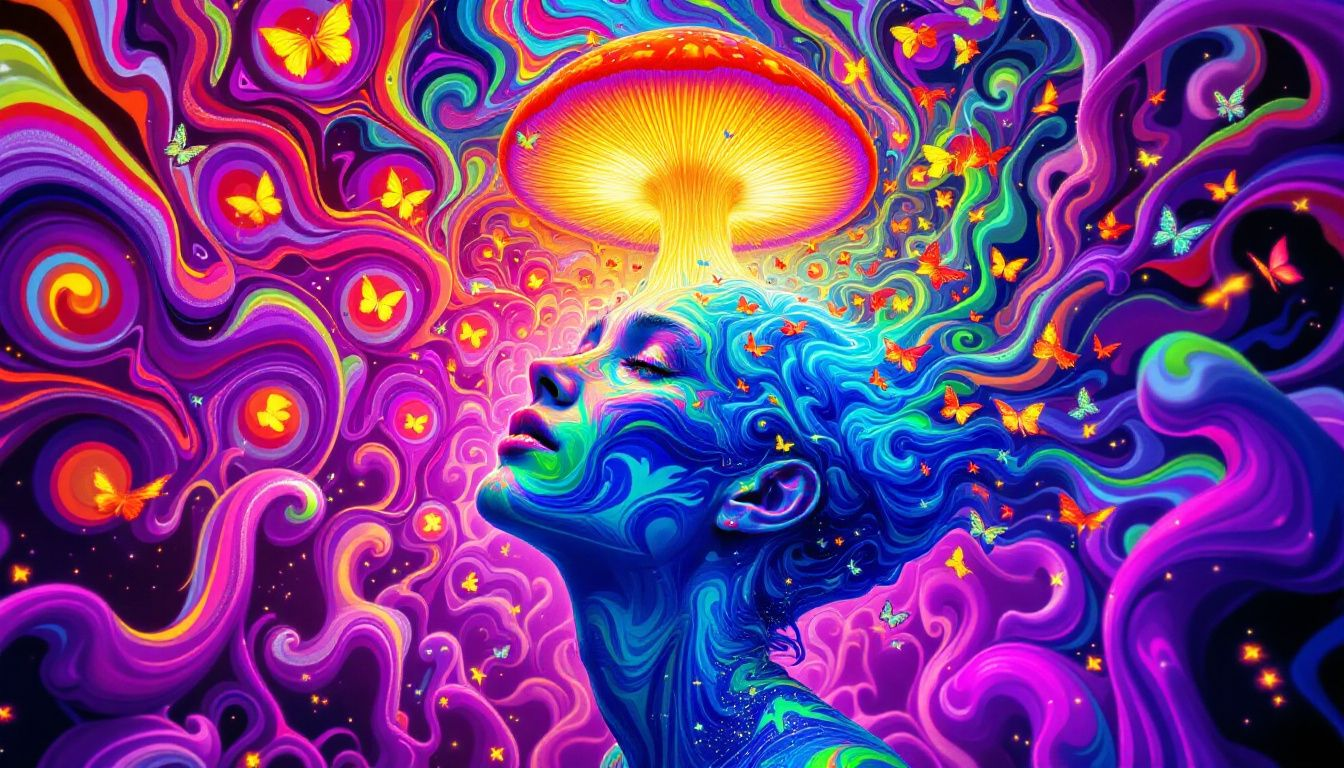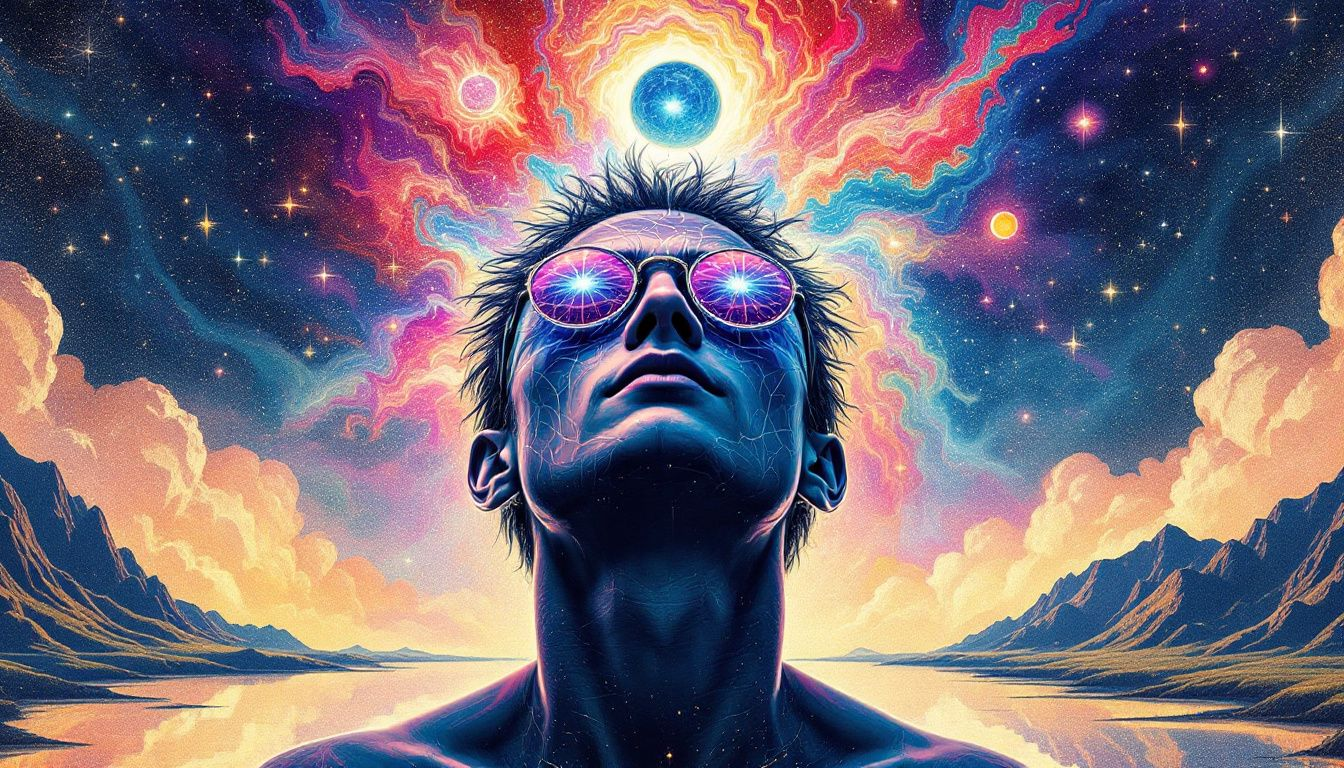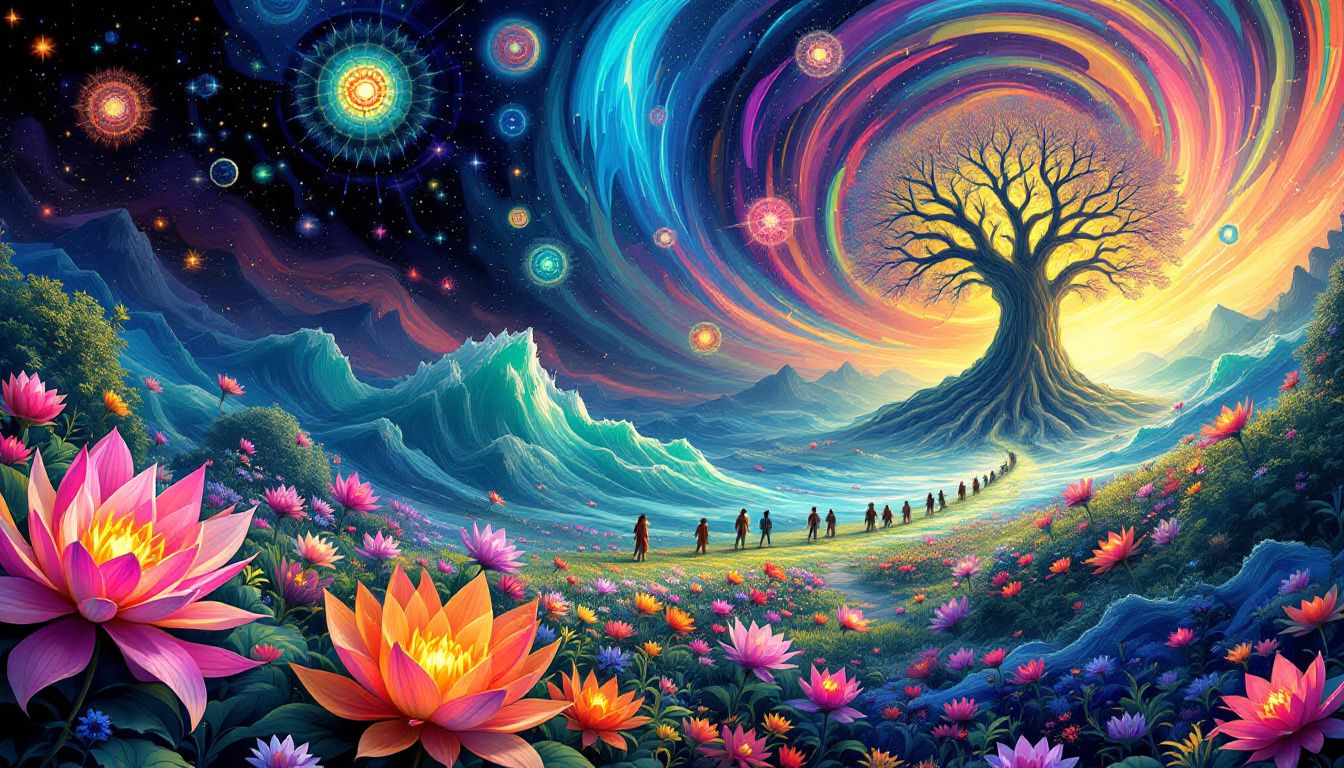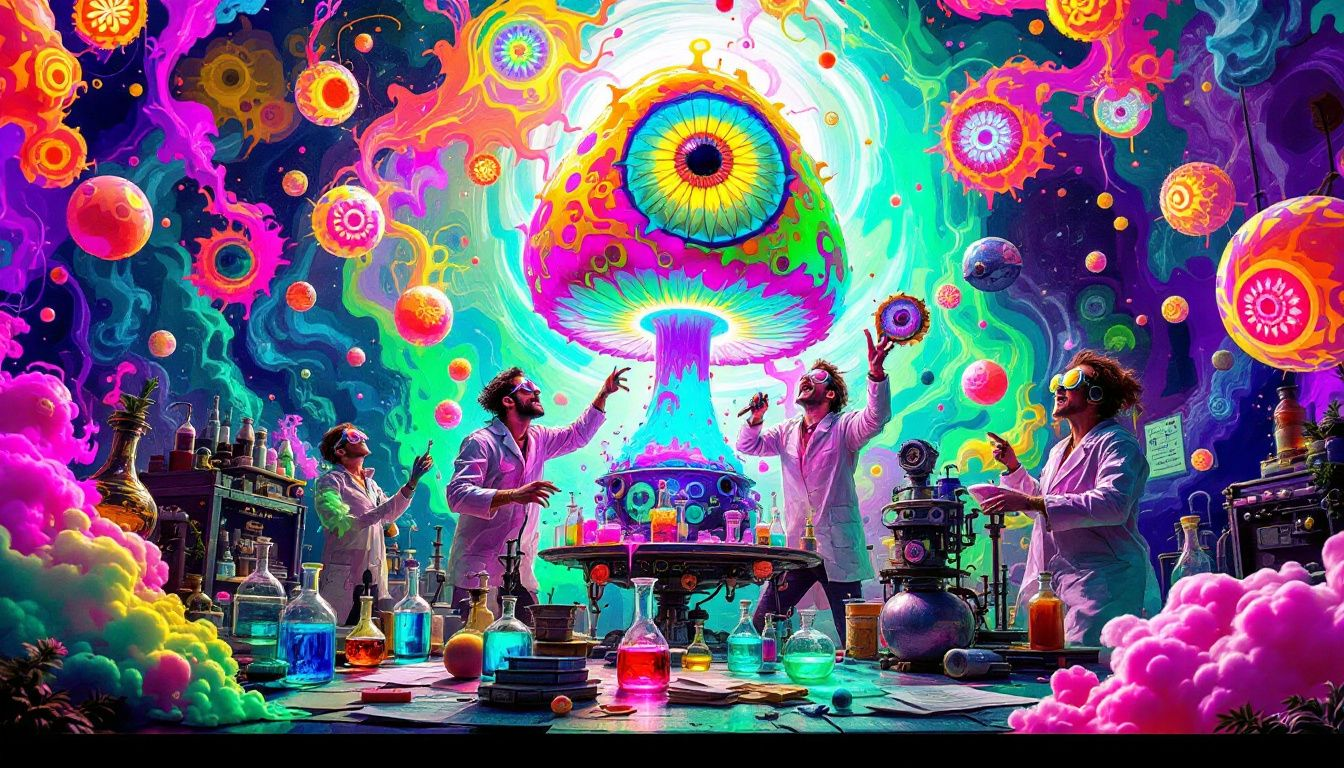Acid vs Shrooms: Key Differences and Effects
When choosing between acid (LSD) and shrooms (psilocybin mushrooms), understanding their key differences is crucial. In this article, we will compare their effects, chemical compositions, how they influence the brain, and safety concerns. Dive in to learn more about acid vs shrooms.
Key Takeaways
LSD and psilocybin mushrooms are distinct psychedelics, with LSD being a synthetic compound and psilocybin a naturally occurring substance, each impacting perception and cognition in unique ways.
Despite similar mechanisms of action on serotonin receptors, LSD effects last longer (up to 10 hours) compared to psilocybin mushrooms (4-6 hours), leading to different subjective experiences.
The legal landscape for LSD and psilocybin mushrooms is changing, with increasing bipartisan support for psychedelic decriminalization and research into their therapeutic applications.
What are Acid and Shrooms?
LSD (lysergic acid diethylamide) and psilocybin mushrooms, commonly known as magic mushrooms or shrooms, are psychedelics renowned for their deep impact on perception, cognition, and mood. LSD, a semi-synthetic derivative of lysergic acid, was first synthesized by Albert Hofmann in 1938 and gained significant cultural influence during the 1960s, particularly in art and music. Psilocybin mushrooms, on the other hand, are naturally occurring fungi containing the psychoactive compound psilocybin, which converts to psilocin in the human body.
Although both LSD and psilocybin mushrooms have ancient roots, their modern resurgence underscores a renewed interest in their potential benefits and risks. These classic psychedelics offer unique and transformative experiences, often described as a journey into altered states of consciousness.
Knowing their origins and historical significance helps appreciate the intricate tapestry of psychedelic experiences.
Chemical Composition and Sources
LSD is a synthetic chemical derived from ergot, a mold that grows on certain grains. This powerful compound is typically produced in a laboratory setting, where it undergoes precise synthesis to achieve its potent psychoactive effects. LSD in liquid form is typically applied to blotter paper or sugar cubes, facilitating easy ingestion and dosage control.
In contrast, psilocybin mushrooms are naturally occurring organisms that thrive in tropical and subtropical regions of South America, Mexico, and the United States. These mushrooms contain the psychoactive compound psilocybin, which is responsible for their hallucinogenic effects. Unlike the synthetic nature of LSD, psilocybin mushrooms can be found growing in the wild, often in damp, forested areas.
This essential difference in origin highlights the varied ways these substances are sourced and consumed.
How They Affect the Brain
Both LSD and psilocybin mushrooms exert their hallucinogenic effects by interacting with serotonin receptors in the brain, specifically the 5-HT2A receptor. This binding leads to significant alterations in neural activity, affecting how the brain processes information and resulting in profound shifts in thought, mood, and perception.
The psychoactive effects are central to user experiences, forming the foundation of these substances’ unique impacts on the brain.
Neurochemical Mechanisms
LSD and psilocybin primarily target the serotonin 2A receptors in the brain, playing a crucial role in their psychoactive effects. This interaction is key to the psychedelic experiences associated with both substances, leading to altered perception and cognition. Additionally, psilocin, the active form of psilocybin, also displays activity at H1, alpha-2A, alpha-2B, and D3 receptors, further influencing various neural processes.
LSD, particularly at higher doses, exhibits significant activity at dopamine receptors, adding another layer to its complex neurochemical profile. These interactions with various neurotransmitter systems contribute to the diverse experiences reported by users, from visual hallucinations to deep emotional and mystical states.
Duration and Intensity
The onset for both LSD and psilocybin mushrooms is approximately one hour when taken on an empty stomach. However, the duration and intensity of their effects differ significantly. An LSD experience can last up to 10 hours, offering a longer duration compared to the 4 to 6 hours typically associated with a mushroom trip. This longer duration can influence the overall impact and depth of the experience, making LSD trips more prolonged and often more intense.
Mushrooms generally result in a full-body experience, characterized by sensations throughout the entire body, while LSD primarily provides a cerebral experience, affecting the mind more intensely. These experiential differences emphasize the distinct effects of these substances, contributing to their unique profiles in the world of psychedelics.
Subjective Experiences and Perceptual Changes
LSD and psilocybin mushrooms are famous for inducing deep subjective experiences and perceptual changes. Users commonly report visual hallucinations, time distortion, and altered mood and cognition while under the influence of these substances. These experiences can vary based on factors like personal mindset, setting, and dosage, resulting in a wide array of psychedelic effects.
Visual and Auditory Hallucinations
Visual hallucinations are a hallmark of both LSD and psilocybin mushroom trips. Users often describe seeing waves or ripples on surfaces, enhanced colors, and increased brightness. These visual distortions can be vivid and immersive, adding to the overall intensity of the psychedelic experience. Auditory hallucinations, though less commonly detailed, also play a significant role in the altered perception induced by these substances.
These sensory distortions are key to understanding the subjective nature of psychedelic experiences. They highlight the profound ways in which these substances can alter perception, leading to a deeply immersive and often transformative journey.
Emotional and Mystical Experiences
Beyond visual and auditory hallucinations, LSD and psilocybin mushrooms often evoke profound emotional and mystical experiences. Users report feeling a deep sense of connection to themselves and others, experiencing emotions ranging from bliss and awe to universal love. These experiences can be incredibly meaningful, providing insights and perspectives that resonate long after the trip has ended.
However, not all experiences are positive. Some users may encounter challenging or frightening hallucinations, leading to anxiety, fear, and paranoia. Recognizing the potential for challenging experiences and preparing can help navigate difficult moments, ensuring a safer journey.
Risks and Safety Profiles
While LSD and psilocybin mushrooms are generally not considered physically addictive, they do carry potential risks related to drug abuse. Psychological dependence can develop, particularly with regular use, and both substances can cause psychological distress or discomfort.
Recognizing these risks is essential for anyone considering psychedelics.
Psychological and Physiological Effects
The psychological effects of LSD and psilocybin mushrooms can include anxiety, fear, and paranoia, especially during a bad trip. These adverse reactions can lead to significant psychological distress, with some individuals reporting their bad trips as among the most difficult experiences of their lives. Physiological effects can also occur, such as changes in blood pressure and the potential for health risks when used alongside other drugs, like antidepressants.
While the overall safety profiles of LSD and psilocybin mushrooms are favorable, with minimal physiological harm and no evidence of organ damage, the psychological impacts can be profound and sometimes troubling. Acknowledging the potential for adverse effects is vital for responsible use and harm reduction.
Long-Term Effects and Recurring Symptoms
Long-term effects of LSD and psilocybin mushrooms can include hallucinogen-persisting perception disorder (HPPD), a condition characterized by recurrent, spontaneous visual disturbances that resemble those experienced during a trip. This condition is more likely to occur in chronic users, particularly those with pre-existing mental health issues. Recognizing the signs of HPPD and understanding its potential impact is crucial for long-term well-being.
While HPPD and other long-term effects are relatively rare, they underscore the importance of cautious use and awareness of potential risks. Individuals with a history of mental health disorders should approach psychedelics with particular care.
Responsible Use and Harm Reduction
Responsible use of LSD and psilocybin mushrooms involves understanding individual tolerance levels and ensuring a supportive environment. Harm reduction strategies focus on minimizing negative consequences, emphasizing informed and cautious use.
These principles are essential for anyone exploring the world of psychedelics.
Dosage and Set & Setting
Safe dosage ranges are critical for reducing the risk of adverse reactions during psychedelic experiences. Knowing the appropriate dosage for your tolerance and experience level can significantly enhance trip safety and enjoyment.
Equally important is the concept of set and setting. Adequate preparation, including a supportive environment and positive mindset, can greatly enhance the psychedelic experience and mitigate potential risks.
Recognizing Adverse Effects
Identifying and responding to adverse effects is vital for safe psychedelic use. Common adverse reactions include panic, anxiety, and psychotic-like symptoms, which can be distressing and potentially harmful. Being aware of these symptoms and knowing when to seek emergency medical treatment is crucial for ensuring safety during a trip.
By recognizing these adverse effects, users can take proactive steps to mitigate risks and ensure a safer, controlled psychedelic experience. This knowledge is a key component of responsible use and harm reduction.
Comparing Usage Methods
The methods of using LSD and psilocybin mushrooms differ significantly, reflecting their distinct chemical properties and forms. Neither LSD nor psilocybin mushrooms are commonly snorted or smoked, as these methods are not suitable for these substances.
Knowing the common ingestion methods is crucial for ensuring proper dosage and maximizing the safety and effectiveness of the experience.
Ingesting LSD
LSD is commonly ingested in various forms, including liquid drops, blotter paper, and sugar cubes. The liquid form of LSD is often dispensed using a dropper, allowing users to precisely control their intake. This method is favored for its ease of use and accuracy in dosing.
Blotter paper, another popular form, involves soaking small squares of paper in LSD solution. When placed on the tongue, the LSD is absorbed through the mucous membranes, facilitating a controlled and efficient delivery of the substance.
Knowing these forms and their proper use is essential for anyone considering an LSD trip, ensuring a safe and effective experience.
Consuming Psilocybin Mushrooms
Psilocybin mushrooms are typically consumed by eating dried mushrooms or brewing them into tea. Eating dried shrooms can be an intense experience due to their strong taste and texture. To mask the taste, some users mix them into food, such as peanut butter or smoothies. This method makes the consumption process more palatable while preserving the mushroom’s psychoactive properties.
Another popular method is brewing psilocybin mushrooms into tea, which can help reduce nausea caused by chitin in the mushroom cell walls. Additionally, mushrooms can be prepared in capsules, offering a tasteless and convenient way to consume psilocybin. These methods cater to different preferences, ensuring a more pleasant and manageable mushroom trip.
Legal Status and Clinical Research
The legal status of LSD and psilocybin mushrooms has been contentious, with significant changes in recent years. As of early 2023, 25 states have introduced 74 bills concerning the regulation of psychedelics, with 10 of those bills becoming law. Legislative interest in decriminalizing psychedelics has risen sharply, reflecting a growing bipartisan movement towards psychedelic drug reform in the United States.
Oregon was the first state to legalize psilocybin for therapeutic use and decriminalize its possession in 2020. This landmark decision has sparked renewed interest in the therapeutic potential of psychedelics, leading to increased clinical research. Studies have demonstrated the therapeutic value of psilocybin in treating certain psychiatric conditions, and the FDA has granted breakthrough therapy designation for its use in treating depression.
Although research on LSD has been limited since the 1970s, there is a renewed interest in exploring its therapeutic applications.
Summary
LSD and psilocybin mushrooms are fascinating substances that offer profound and transformative experiences. Understanding their chemical compositions, effects on the brain, subjective experiences, and potential risks is crucial for informed and responsible use. As the legal landscape evolves and clinical research progresses, these classic psychedelics continue to captivate the imagination and offer promising therapeutic potential. By approaching their use with caution and respect, individuals can explore the depths of human consciousness while minimizing risks and maximizing benefits.
The main differences between LSD and psilocybin mushrooms lie in their origins and effects; LSD is a synthetic compound from ergot fungi that delivers a longer, cerebral experience, while psilocybin mushrooms are natural fungi resulting in a shorter, more holistic experience. Therefore, your choice may depend on the desired duration and nature of the psychedelic experience.
LSD and psilocybin mushrooms significantly alter brain function by interacting with serotonin receptors, especially the 5-HT2A receptor, which results in profound changes in thought, mood, and perception. This interaction can lead to unique psychological experiences and altered states of consciousness.
The potential risks of using LSD and psilocybin mushrooms include psychological dependence, adverse psychological reactions like anxiety and paranoia, and long-term effects such as hallucinogen persisting perception disorder (HPPD). It is crucial to approach these substances with caution due to their profound impact on mental health.
LSD is typically ingested via liquid drops, blotter paper, or sugar cubes, while psilocybin mushrooms are usually consumed by eating dried mushrooms, brewing them into tea, or using capsules.
LSD and psilocybin mushrooms remain largely illegal under federal law, but there is growing legislative interest in decriminalizing them in various states. Notably, Oregon has legalized psilocybin for therapeutic use and decriminalized its possession.
















